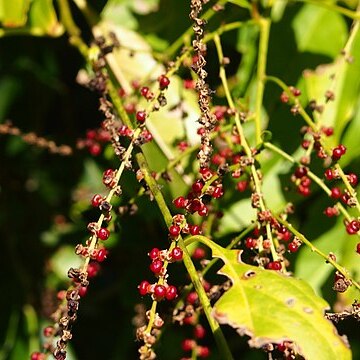Shrub, slender, scrambling, or climber to 2–6 m high with long arching branches. Leaves: petiole (3–) 10–30 (–35) mm long; lamina ovate to elliptical, sometimes narrower, (15–) 20–105 (–120) mm long, (8–) 10–50 (–60) mm wide, with base shortly attenuate to cuneate, acuminate, and both surfaces glabrous to sparsely hairy. Inflorescence spike-like, occasionally branched, terminal and axillary (47–) 60–180 (–230) mm long; peduncle (5–) 10–35 (–45) mm long; bracts ovate, sometimes narrower, (0.8–) 1.0–1.5 (–2.5) mm long, acuminate, glabrous or with hairs on basal margins; bracteoles ovate to broadly ovate, 0.7–1 (–1.4) mm long, acute to subacute, glabrous or with hairs on basal margins. Flower bisexual, single, sometimes 2 or 3 together; pedicel 1–1.5 (–2) mm long. Tepals elliptical to ovate, (1.2–) 1.5–2.5 (–3.1) mm long, obtuse. Style 0–0.5 mm long; stigma 2-or 3-fid. Fruit 3–6 mm wide, red to purple. Seeds 1–9 ovoid, 1.0–1.5 (–2.0) mm wide, smooth.
Shrubs climbing. Stem 2-6 m tall, often with pendulous branches, hairy when young. Petiole 1-4 cm, glabrous; leaf blade ovate or ovate-lanceolate, at first sparsely villous, glabrescent, base acute, obtuse, rounded, or ovate-subtruncate, apex acuminate or acute, often unequal. Racemes axillary and terminal, arranged into complex thyrsoid structures; rachis pubescent. Bracts narrowly triangular, ca. 1.5 mm; bracteoles ovate, ca. 1 mm. Pedicel 2-3 mm. Flowers broadly spreading or reflexed at anthesis, glabrous, apex ?obtuse. Tepals light green or somewhat yellowish, tinged red in fruit, 1.5-2.5 mm. Filaments connate into a cup at base; stigmas 3, terete, reflexed in fruit. Berry red, globose, 4-7 mm in diam. Seeds 1-6, black, shiny, compressed-reniform. Fl. and fr. Oct-Mar. 2n = 16.
A small shrub or climber up to 5 m tall. The stem is woody and it branches. Young shoots are slender and smooth. The leaves are alternate and oval or sword shaped. They are 10 cm long and 2-4 cm wide. They are drawn out to a long point and are bright green with a thin texture. The flowers occur in slender spikes up to 25 cm long. These are in the axils of the upper leaves. Flowers are 0.4 cm across and greenish white. Flowers contain both sexes. Seeds are about 1.2 mm across, smooth and black. They are inside a bright red berry which is carried in clusters on long slender spikes. The fruit are 0.5 cm long with 3 furrows long it.

